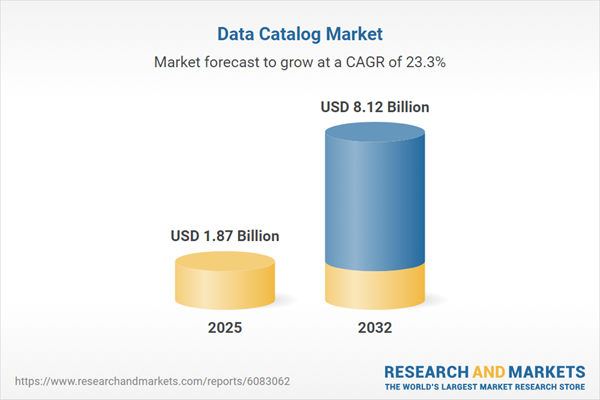Speak directly to the analyst to clarify any post sales queries you may have.
The data catalog market is emerging as a critical enabler for organizations seeking unified control and governance of their enterprise information assets. With increasingly complex regulatory environments and proliferating data sources, senior leadership teams are prioritizing modern catalog solutions to strengthen governance and unlock more value from their company-wide data resources.
Market Snapshot: Data Catalog Market Size and Growth
The data catalog market continues to expand rapidly, with industry research showing growth from USD 1.52 billion in 2024 to USD 1.87 billion in 2025, reflecting a notable compound annual growth rate (CAGR) of 23.25%. Projections indicate the market could reach USD 8.12 billion by 2032. This upward trend is attributed to increased investment in metadata management and the growing need for streamlined, sophisticated information governance. The deployment of AI-driven analytics across diverse industries further underscores market acceleration. Stricter regulatory standards and the drive among enterprises to secure and control distributed data assets are propelling widespread adoption of data catalog solutions.
The Data Catalog Market: Scope & Segmentation
- Product Type: Hardware appliances designed for high-speed indexing support demanding enterprise needs; software platforms act as crucial integration points for analytics environments; specialized service offerings provide expertise for deploying and scaling robust metadata cataloging solutions.
- Deployment Type: Cloud-based models are chosen for their on-demand scalability and rapid provisioning, optimizing resource use and agility for distributed teams. On-premise deployments remain essential for companies with strict regulatory, compliance, or data residency standards.
- Applications: Analytics departments utilize data catalogs to enrich reporting and bolster data transparency; seamless cloud connectors support the establishment of continuous, reliable data pipelines; embedded audit trails reinforce robust data security regimes; network management benefits from automated data lineage mapping to sustain data quality and integrity.
- End Users: This market serves financial services firms, insurers, healthcare providers, IT and telecommunications companies, manufacturers, and retailers—each requiring uniquely tailored features for compliance, operational efficiency, and risk management.
- Region: Market coverage spans the Americas (including United States, Canada, Mexico, Brazil, Argentina, Chile, Colombia, Peru), EMEA (such as the UK, Germany, France, Russia, UAE, South Africa, Nigeria), and Asia-Pacific (notably China, India, Japan, Australia, South Korea, Indonesia, Thailand, Malaysia, Singapore, Taiwan), capturing the full spectrum of regulatory landscapes and adoption trajectories.
- Companies: Leading market players—such as Informatica LLC, Collibra NV, Alation, International Business Machines Corporation, Talend S.A., Oracle Corporation, SAP SE, Microsoft Corporation, Amazon Web Services, Atlan Pte. Ltd., among others—distinguish themselves through expansive technology offerings and deep expertise in data catalog implementation.
Key Takeaways for Senior Decision-Makers
- Comprehensive data catalog platforms enable consistent metadata discovery across departments, enhancing transparency and accelerating informed decision-making for complex business environments.
- Advanced AI capabilities within these solutions automate the classification and enrichment of information assets, promoting higher productivity and reduced manual involvement for data teams.
- Adopting cloud-native frameworks allows seamless integration with hybrid and diversified technology environments, supporting rapid scaling and operational continuity across the enterprise.
- Role-based access and user-friendly interfaces empower business stakeholders to interact directly with data catalogs, reducing dependency on central IT functions and optimizing resource allocation.
- Compliance features built into platforms simplify the achievement of regional and sector-specific regulatory objectives, helping organizations manage evolving privacy, audit, and governance obligations.
- Vendor competition is increasingly focused on enhancing extensibility, deepening integration, and forging strategic alliances, all of which influence enterprise vendor selection criteria and best practice trends in metadata management.
Assessing Tariff Impact on Data Catalog Deployment and Procurement
Recent U.S. tariff changes effective from 2025 have led organizations to re-examine how they source and deploy data catalog technologies. Hardware pricing volatility has encouraged a shift toward software-as-a-service procurement, optimizing cost control and reducing capital expenditure risks. In response, leading vendors are strengthening their focus on regional alliances and offering adaptive pricing models to accommodate ongoing tariff uncertainties. These actions provide resilience for global metadata governance initiatives, supporting strategic continuity despite shifts in the economic environment.
Methodology & Data Sources
Findings are based on primary interviews and workshops with IT and data management leaders, as well as secondary analysis from public regulatory documents, vendor materials, and peer-reviewed case studies. Rigorous validation procedures ensure that all insights deliver high reliability and value for enterprise leaders evaluating the data catalog market.
Why This Report Matters: For Enterprise Leaders
- Clarifies how modern data catalog platforms drive both strategic value and support operational risk reduction within complex data management programs.
- Guides enterprises in selecting optimal products, deployment strategies, and governance models suited to their global and multi-jurisdictional operations.
- Empowers decision-makers with thoroughly validated research for evaluating competitive vendors and adopting best practice metadata management approaches.
Conclusion
As artificial intelligence, cloud innovation, and evolving regulations reshape enterprise data management, those organizations with a clear grasp of these market forces will be best equipped to pursue sustained, data-driven growth and competitive advantage.
Table of Contents
3. Executive Summary
4. Market Overview
7. Cumulative Impact of Artificial Intelligence 2025
Companies Mentioned
The companies profiled in this Data Catalog market report include:- Informatica LLC
- Collibra NV
- Alation, Inc.
- International Business Machines Corporation
- Talend S.A.
- Oracle Corporation
- SAP SE
- Microsoft Corporation
- Amazon Web Services, Inc.
- Atlan Pte. Ltd.
Table Information
| Report Attribute | Details |
|---|---|
| No. of Pages | 189 |
| Published | October 2025 |
| Forecast Period | 2025 - 2032 |
| Estimated Market Value ( USD | $ 1.87 Billion |
| Forecasted Market Value ( USD | $ 8.12 Billion |
| Compound Annual Growth Rate | 23.2% |
| Regions Covered | Global |
| No. of Companies Mentioned | 11 |









